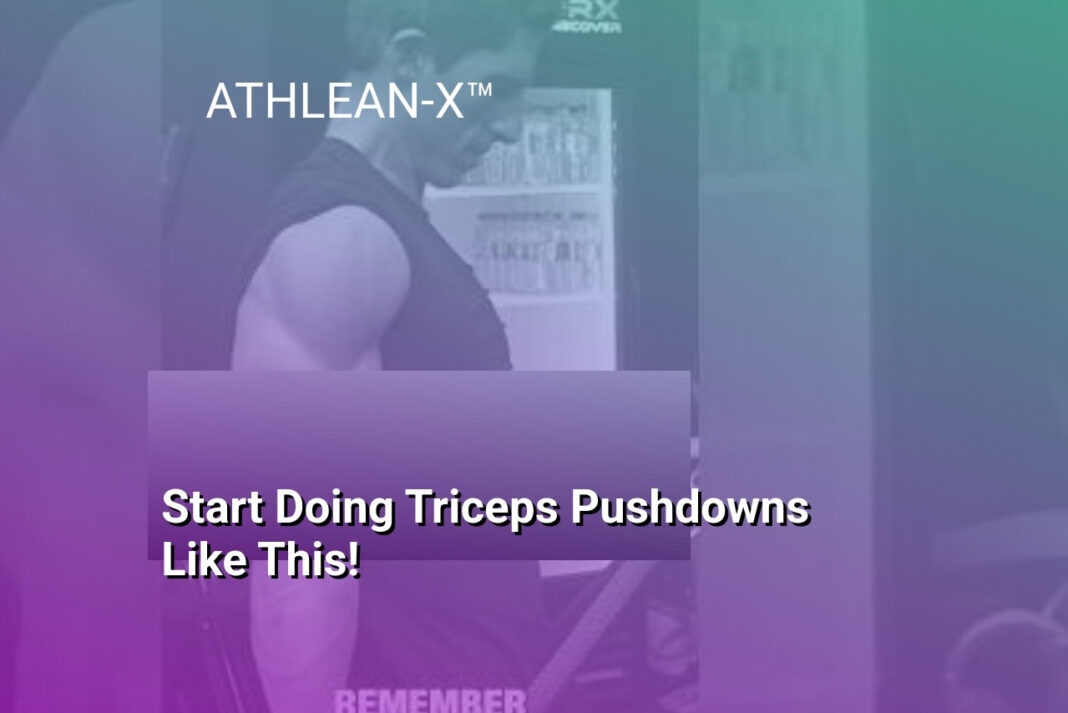The Bottom Line:
- I discovered a specialized triceps pushdown technique that maximizes muscle engagement by maintaining optimal cable angle throughout the exercise
- The rocking stance involves strategic foot positioning to create consistent resistance and tension on the triceps muscles
- By focusing on precise body mechanics, I learned to minimize momentum and isolate the triceps for more targeted strength training
- The method emphasizes technical execution over weight lifted, prioritizing muscle activation and proper form
- This innovative approach transforms a standard cable exercise into a more deliberate and effective triceps workout strategy
Understanding Cable Tension in Triceps Training
Biomechanics of Cable Resistance
Cable tension plays a critical role in maximizing triceps muscle activation during pushdown exercises. The traditional pushdown movement creates variable resistance throughout the range of motion, with peak tension occurring when the cable remains perpendicular to the forearm. Understanding these biomechanical nuances allows athletes to optimize muscle recruitment and minimize energy waste during the exercise.
Optimizing Force Vectors
By strategically positioning the body and adjusting cable angle, lifters can maintain consistent tension on the triceps muscle group. The rocking pushdown technique provides a sophisticated approach to managing resistance, allowing for continuous muscle engagement from the top to bottom of the movement. This method involves subtle weight distribution and foot positioning that creates a more uniform force application across the entire exercise range.
Muscle Activation Strategies
Effective triceps training requires precise movement execution that prioritizes muscle tension over momentum. Athletes must focus on controlled movements, avoiding unnecessary body swaying or leveraging body weight to complete repetitions. The key is maintaining a strict form where the triceps muscles bear the primary load, ensuring targeted muscle development and minimizing potential compensation patterns that could reduce exercise effectiveness. By concentrating on deliberate, controlled movements and understanding cable resistance dynamics, lifters can significantly enhance their triceps training outcomes and promote more consistent muscle growth.
The Rocking Pushdown Method: Advanced Positioning Technique
Biomechanical Advantages of the Rocking Technique
The rocking pushdown method revolutionizes traditional cable triceps training by strategically manipulating body positioning to maximize muscle tension. By creating a dynamic stance that shifts weight distribution, lifters can maintain consistent resistance throughout the entire range of motion. The key is positioning one foot slightly forward and maintaining tension through precise body alignment, which prevents momentum-driven movements and ensures targeted triceps engagement.
Optimizing Muscle Activation Mechanics
When executing the rocking pushdown, the critical element is maintaining a perpendicular cable angle relative to the forearm. Traditional pushdown variations often lose tension at the bottom of the movement, but this advanced technique keeps constant muscular stress on the triceps. By subtly leaning into the back foot and controlling the rope’s trajectory, athletes can create continuous resistance that challenges the muscle group more effectively than standard isolation exercises.
Precision Execution and Form Refinement
Proper implementation requires meticulous attention to body mechanics. Athletes must avoid compensatory movements like excessive torso leaning or using body momentum. Instead, the focus remains on creating a stable platform where the triceps perform the primary work. The rocking technique demands core engagement, balance, and deliberate muscle control, transforming a seemingly simple exercise into a sophisticated muscle-building movement that targets the triceps with unprecedented precision and intensity.
Maximizing Muscle Engagement Without Momentum
Strategic Body Positioning for Enhanced Muscle Activation
Achieving optimal triceps engagement requires precise body mechanics that minimize momentum and maximize muscle tension. By strategically positioning your body, you can create a biomechanical advantage that forces the triceps to bear the primary load throughout the entire range of motion. The key lies in maintaining a consistent angle between your forearms and the cable, which ensures continuous muscle stimulation and reduces the likelihood of energy dissipation.
Eliminating Compensatory Movement Patterns
Most lifters unconsciously recruit secondary muscle groups to complete triceps pushdowns, thereby reducing the targeted muscle’s workload. Common compensation strategies include excessive torso leaning, hip thrust, and uncontrolled arm swinging. These movement deviations not only diminish triceps activation but also increase the risk of potential injury. By consciously stabilizing your core and maintaining a vertical torso position, you create an environment where the triceps muscles are forced to perform the primary work.
Tension Management and Muscle Recruitment
The secret to maximizing muscle engagement lies in understanding and controlling muscular tension throughout the exercise. By maintaining a slight forward lean and anchoring your back foot, you create a stable platform that allows for precise movement execution. This approach ensures that the triceps experience consistent resistance from the cable, preventing momentum-driven repetitions and promoting muscle fiber recruitment across different angles of the movement. The goal is to transform each repetition into a deliberate, controlled action that challenges the triceps through its entire functional range.
Body Mechanics for Targeted Triceps Activation
Optimizing Cable Angle for Maximum Muscle Engagement
Understanding the biomechanical principles of triceps pushdowns is crucial for targeted muscle activation. Traditional pushdown techniques often result in suboptimal muscle tension, particularly at the bottom range of motion. By strategically positioning your body and maintaining a precise cable angle, you can dramatically increase triceps muscle recruitment and mechanical stress.
The key is to maintain a near-perpendicular relationship between the cable and your forearm throughout the entire movement. This positioning ensures consistent resistance and prevents momentum-driven repetitions that diminish muscle stimulation. Subtle adjustments in body positioning can transform an average pushdown into a highly effective triceps isolation exercise.
Strategic Body Positioning Techniques
Advanced practitioners utilize a dynamic foot placement strategy to enhance triceps engagement. By positioning one foot slightly forward and maintaining a slight forward lean, you create a biomechanical advantage that locks the upper arms into an optimal position. This technique prevents unnecessary body movement and concentrates force directly through the triceps muscle group.
The forward foot placement allows you to generate a stable platform, enabling more precise movement control. Your back foot acts as a counterbalance, helping maintain tension and preventing unwanted body sway. This approach transforms the pushdown from a basic cable exercise into a highly targeted muscle development movement.
Minimizing Momentum and Maximizing Muscle Tension
Eliminating momentum is critical for genuine muscle growth and strength development. Many lifters unconsciously use body English to complete repetitions, which significantly reduces muscle activation. By consciously focusing on a controlled, deliberate movement pattern, you create continuous tension on the triceps throughout the entire range of motion.
Concentrate on initiating the movement from the triceps, keeping your elbows pinned close to your torso. The goal is to create a movement where your forearms are the primary lever, with minimal involvement from other muscle groups. This precise approach ensures that the triceps bear the primary load, leading to more effective muscle stimulation and potential hypertrophy.
Pro Tips for Perfecting Your Pushdown Form
Optimize Cable Angle for Maximum Muscle Activation
Understanding cable positioning is crucial for effective triceps pushdowns. By maintaining a near-perpendicular angle between the cable and your forearm throughout the entire movement, you create consistent tension on the triceps muscle group. This strategic positioning ensures that the muscle remains engaged from the top of the movement to the bottom, preventing momentum-driven repetitions and maximizing muscle recruitment.
Body Mechanics and Stance Precision
Implementing the strategic foot placement technique can dramatically improve your pushdown performance. By positioning one foot slightly forward and maintaining a subtle forward lean, you create a stable platform that allows for more controlled and targeted triceps activation. The key is to distribute your weight strategically, allowing your back foot to provide stability while your front foot helps maintain proper body alignment. This approach prevents unnecessary body swaying and ensures that the triceps remain the primary muscle group driving the movement.
Technique Refinement for Muscle Engagement
Eliminating momentum and focusing on pure muscle contraction is critical for pushdown effectiveness. Concentrate on initiating the movement from your triceps, keeping your elbows stationary and close to your body. Avoid the common mistake of using body weight or swinging to complete the repetition. Instead, focus on a controlled, deliberate movement where the triceps are doing the primary work. Imagine your elbows as a fixed pivot point, with the forearms moving in a precise, controlled arc. This approach ensures maximum muscle tension and minimizes the risk of compensatory movements that can reduce the exercise’s overall effectiveness.





